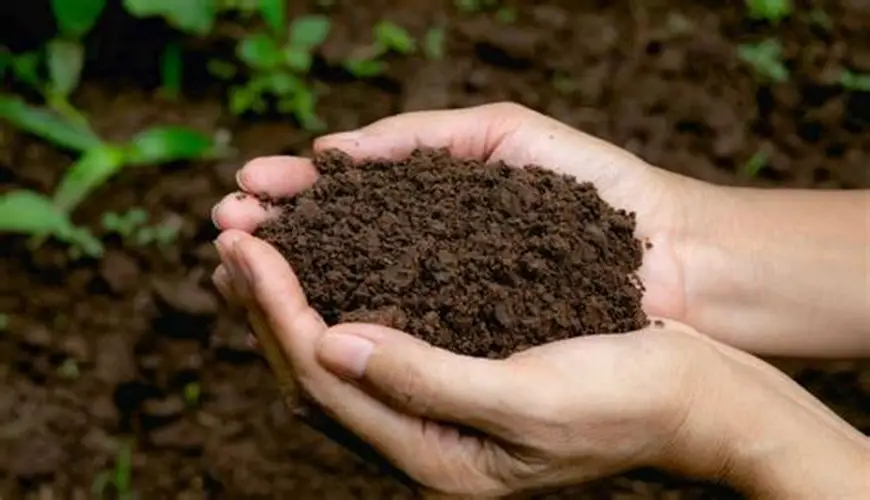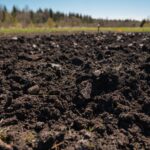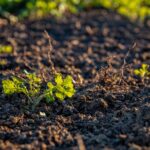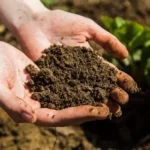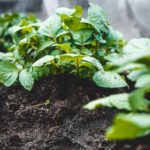Potassium humate, a natural organic compound derived from decomposed organic matter like leonardite or lignite, is widely recognized in agriculture for its ability to significantly improve soil health. Rich in humic and fulvic acids, it acts as a soil conditioner, enhancing soil structure, nutrient availability, water retention, and microbial activity.
Why Potassium Humate Improves Soil Health
Soil health is the foundation of productive agriculture, as it determines how well plants can grow, absorb nutrients, and withstand challenges like drought or pests. Potassium humate supports soil health by:
- Improving soil structure, making it looser and better for root growth.
- Increasing the soil’s ability to hold nutrients and water, reducing waste.
- Feeding beneficial soil microbes that break down organic matter and release nutrients.
- Balancing soil pH to make nutrients more available to plants.
- Reducing soil erosion and nutrient leaching in rainy or irrigated areas.
- Supporting long-term fertility for sustainable farming and gardening.
As a natural product, potassium humate is especially valuable in organic farming but works well in all types of agriculture, from large farms to small backyard gardens. It’s easy to apply, cost-effective over time, and eco-friendly, making it a go-to solution for building healthier soils.
How Potassium Humate Enhances Soil Health
1. Improves Soil Structure
- What It Does: Potassium humate makes soil less compact and more crumbly, creating a better environment for roots to grow. It helps sandy soils hold together better and loosens heavy clay soils, improving aeration and drainage.
- Why It Matters: Loose, well-aerated soil allows roots to spread out, access more nutrients and water, and grow stronger. Better soil structure also helps water penetrate deeper, reducing runoff and erosion.
2. Enhances Nutrient Retention
- What It Does: Potassium humate acts like a sponge, holding onto essential nutrients (e.g., nitrogen, phosphorus, potassium, iron, zinc) so they stay in the soil instead of washing away. It keeps nutrients in a form plants can easily absorb.
- Why It Matters: This reduces fertilizer waste, saves money, and ensures plants have a steady supply of nutrients, even in rainy or irrigated areas.
3. Boosts Microbial Activity
- What It Does: The organic carbon in potassium humate feeds beneficial soil microbes, such as bacteria and fungi, which break down organic matter and release nutrients for plants.
- Why It Matters: Active microbes create a thriving soil ecosystem, improving nutrient cycling and long-term fertility. This makes the soil more productive for future crops.
4. Increases Water Retention
- What It Does: Potassium humate improves the soil’s ability to hold water, especially in sandy or dry soils, by creating a more porous structure that traps moisture.
- Why It Matters: Better water retention keeps soils moist longer, reducing irrigation needs and helping plants survive dry spells.
5. Balances Soil pH
- What It Does: Potassium humate helps adjust soil pH, making it less acidic or alkaline, so nutrients are more available to plants.
- Why It Matters: In acidic soils (pH below 6), nutrients like iron or magnesium can become locked up. In alkaline soils (pH above 7.5), other nutrients may be unavailable. Potassium humate brings pH closer to neutral (6–7), improving nutrient access.
6. Reduces Nutrient Leaching and Erosion
- What It Does: By binding nutrients and improving soil structure, potassium humate prevents nutrients from washing away in rain or irrigation and reduces soil erosion.
- Why It Matters: This keeps soils fertile and protects nearby waterways from nutrient runoff, supporting eco-friendly farming.
7. Builds Long-Term Soil Fertility
- What It Does: Regular use of potassium humate adds organic matter to the soil, improving its fertility over time and supporting sustainable agriculture.
- Why It Matters: Healthy soils produce better crops year after year, reducing the need for heavy fertilizer use and improving farm profitability.
Practical Applications for Soil Health
Potassium humate can be applied in several ways to improve soil health, depending on your farming or gardening needs.
1. Soil Application
Purpose: Directly improves soil structure, nutrient retention, and water-holding capacity for long-term soil health.
How to Apply:
- Spread Evenly: Sprinkle potassium humate granules or powder over the soil surface using a fertilizer spreader for large fields or by hand for small gardens.
- Incorporate into Soil: Mix into the top 5–15 cm of soil with a rake, hoe, or tiller to ensure it reaches the root zone. This helps it blend with the soil and start working.
- Water After Application: Apply before rain or irrigation, or water afterward to help the humate settle into the soil and activate its benefits.
- Target Specific Areas: For trees or shrubs, spread around the drip line (the area under the outer edge of the canopy) where roots are most active.
Frequency:
- Apply 1–2 times per growing season, typically at planting and mid-season (e.g., during flowering or fruiting).
- For poor or degraded soils, apply annually to build organic matter and fertility.
- In fertile soils, one application per season may suffice for maintenance.
2. Combination with Fertilizers
Purpose: Enhances fertilizer efficiency by improving nutrient retention in the soil, reducing leaching, and making nutrients more available to plants.
How to Apply:
- Granular Fertilizers (e.g., NPK, urea, compost): Mix potassium humate with fertilizers before spreading. Use a mixer or blend by hand for even distribution.
- Liquid Fertilizers: Add potassium humate to liquid fertilizer solutions for fertigation or soil drenching. Stir well to combine.
- Test Compatibility: Mix small batches first to check for clumping or precipitation. Some fertilizers may not mix well with humate.
- Apply as Usual: Spread blended granular fertilizers or apply liquid mixtures as part of regular fertilization schedules.
Frequency:
- Apply with each fertilizer application, typically at planting, early growth, or mid-season top-dressing.
- For continuous fertigation systems, add potassium humate every 2–4 weeks.
3. Fertigation (Irrigation Systems)
Purpose: Delivers potassium humate to the soil through irrigation, improving nutrient retention, water-holding capacity, and microbial activity in the root zone.
How to Apply:
- Dissolve in Water: Mix potassium humate into irrigation water (20–50 grams per 100 liters for drip/sprinkler systems; 0.1–0.5 grams per liter for hydroponics). Stir well to ensure it’s fully dissolved.
- Add to System: Introduce the solution into drip, sprinkler, or hydroponic irrigation systems, ensuring even distribution to the soil or root zone.
- Use Filters: Install filters in drip systems to prevent clogging from undissolved particles.
- Clean Systems: Flush irrigation lines after use to avoid buildup of humate residues.
Frequency:
- Apply every 2–4 weeks during the growing season, aligning with key growth stages (e.g., vegetative growth, fruiting).
- In hydroponics, add weekly or biweekly, adjusting based on plant response.
Additional Methods Supporting Soil Health
While soil application, fertilizer combinations, and fertigation are the primary methods for improving soil health, other applications of potassium humate can indirectly support soil by enhancing plant growth, which contributes to organic matter through root systems and crop residues.
4. Foliar Spray (Indirect Soil Benefits)
Purpose: While primarily used for plant growth, foliar sprays can improve soil health indirectly by promoting stronger plants that contribute organic matter (e.g., fallen leaves, roots) to the soil.
How to Apply:
- Dissolve 1–2 grams of potassium humate powder per liter of water (or 10–20 ml of liquid formulation per liter). Spray evenly on plant leaves, covering both sides.
- Apply every 10–14 days during growth stages or weekly for stressed plants.
Dosage:
- General crops: 1–2 grams per liter.
- Orchards/vineyards: 1.5–3 grams per liter.
Soil Health Connection: Healthier plants with stronger roots add more organic matter to the soil when they decompose, improving long-term fertility.
5. Seed Treatment (Indirect Soil Benefits)
Purpose: Enhances germination and early root growth, which supports soil health by increasing root biomass and organic matter.
How to Apply:
- Soak seeds in a 0.5–2 grams per liter solution for 4–12 hours, then plant immediately or dry briefly.
- For large-scale planting, coat seeds using a seed treater.
Dosage:
- Small seeds: 0.5–1 gram per liter.
- Large seeds: 1–2 grams per liter.
Soil Health Connection: Stronger seedlings develop extensive root systems, adding organic matter and improving soil structure over time.
Practical Tips for Using Potassium Humate to Improve Soil Health
- Start Conservatively: Begin with lower doses (e.g., 5 kg per hectare for soil, 2 kg per hectare for fertigation) and increase based on soil and plant response. This prevents overuse and saves costs.
- Test Your Soil: Conduct a soil test to check pH, nutrient levels, and organic matter content. Acidic soils (pH below 6) may need higher doses to improve nutrient availability, while neutral soils (pH 6–7) need less.
- Mix Thoroughly: For fertigation or liquid fertilizer mixes, ensure potassium humate is fully dissolved to avoid clogging irrigation systems or uneven application.
- Time Applications Wisely: Apply soil treatments before planting or early in the season to build soil health. Fertigation is best during active growth stages to support nutrient retention.
- Combine with Organic Matter: Mix potassium humate with compost, manure, or cover crops to boost organic matter and enhance microbial activity.
- Check Product Quality: Choose potassium humate with 60–70% humic acid content from reputable suppliers. Low-quality products with fillers may be less effective.
- Store Properly: Keep granules, powders, or liquids in a cool, dry place to prevent clumping or degradation. Seal containers tightly to maintain potency.
- Monitor Soil Changes: Look for signs of improved soil health, such as darker, crumbly soil, better water retention, or stronger plant growth. Test soil periodically to track progress.
- Use in Crop Rotation: Apply higher doses to nutrient-demanding crops (e.g., corn, tomatoes) and lower doses to less demanding crops (e.g., beans) to optimize soil health across seasons.
- Keep Records: Track application dates, methods, dosages, and soil/plant responses to refine your approach over time.
Real-World Success Stories
- Vegetable Farming: A tomato farmer in sandy soil applied 15 kg per hectare at planting and mixed it into the soil, improving water retention and nutrient availability. The result was a 20% increase in yield and healthier soil after one season.
- Orchards: A citrus grower spread 50 grams per tree and used fertigation (3 kg per hectare monthly), enhancing soil fertility and producing juicier oranges with fewer nutrient deficiencies.
- Field Crops: A corn farmer in a dry region applied 10 kg per hectare, improving soil moisture and microbial activity, leading to a 15% higher yield and richer soil.
- Organic Farming: An organic lettuce grower used 12 kg per hectare combined with compost, boosting microbial activity and creating darker, more fertile soil for crisper leaves.
- Turf Management: A sports field manager applied 100 grams per 100 square meters and watered it in, improving soil structure and creating a durable, green turf that withstood heavy use.
Challenges and Precautions
- Overapplication: Too much potassium humate can cause nutrient imbalances or compact the soil in rare cases. Stick to recommended doses and reduce if plants or soil show stress (e.g., poor drainage, plant yellowing).
- Product Variability: Different brands have varying humic acid content (50–80%). Check labels and choose products with at least 60–70% humic acid for best results.
- Soil Testing: Test soil pH, nutrient levels, and organic matter before applying to avoid overuse in fertile soils or underuse in poor soils.
- Environmental Factors: In wet climates, split soil applications to prevent nutrient leaching. In dry areas, focus on soil applications to boost water retention.
- Equipment Maintenance: Clean irrigation systems after fertigation to prevent clogging from humate residues.
- Cost Considerations: Initial costs may be a concern for small-scale farmers, but bulk purchases or local suppliers can reduce expenses.
- Availability: High-quality potassium humate may not be available everywhere, so source from trusted suppliers.
Additional Considerations for Soil Health
- Long-Term Use: Apply potassium humate annually or biannually to build organic matter and maintain soil health, especially in degraded or heavily farmed soils.
- Crop Rotation: Use higher doses for nutrient-demanding crops (e.g., corn, tomatoes) and lower doses for less demanding crops (e.g., beans, peas) to optimize soil fertility.
- Organic Farming: Potassium humate is ideal for organic systems, as it’s natural and supports sustainable soil health. Check certification requirements for organic use.
- Cover Crops: Combine with cover crops like clover or rye to add organic matter and enhance microbial activity.
- Soil Monitoring: Periodically check soil texture, moisture, and fertility to track improvements and adjust applications as needed.
Conclusion
Potassium humate is a powerful, natural tool for improving soil health in agriculture, making soils more fertile, productive, and sustainable. By applying it through soil treatments, fertilizer combinations, or fertigation, farmers and gardeners can enhance soil structure, nutrient retention, water-holding capacity, and microbial activity. Use 5–30 kg per hectare for soil applications, 5–10 kg per ton of granular fertilizer, or 2–5 kg per hectare for fertigation, tailoring doses to soil type, crop needs, and climate. Start with conservative amounts, test soil conditions, and choose high-quality products for best results. With careful application, potassium humate can transform soils, leading to healthier plants, higher yields, and eco-friendly farming. For tailored advice, consult local agricultural extension services, agronomists, or product suppliers to ensure optimal soil health outcomes for your crops or garden.




